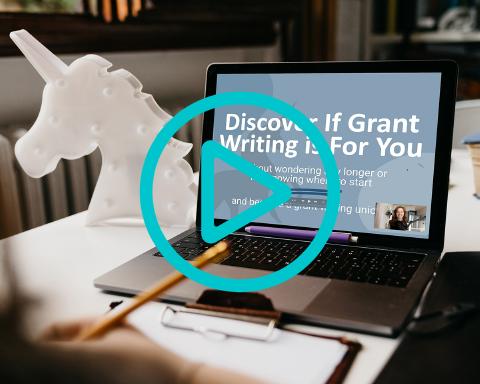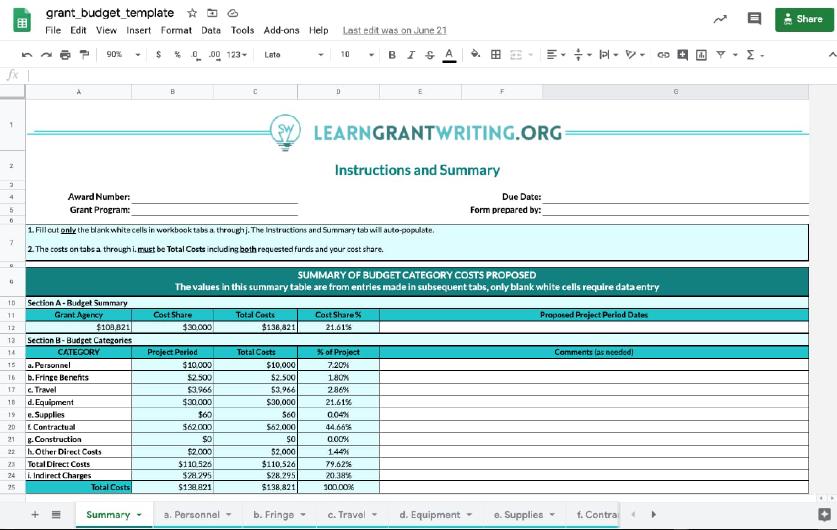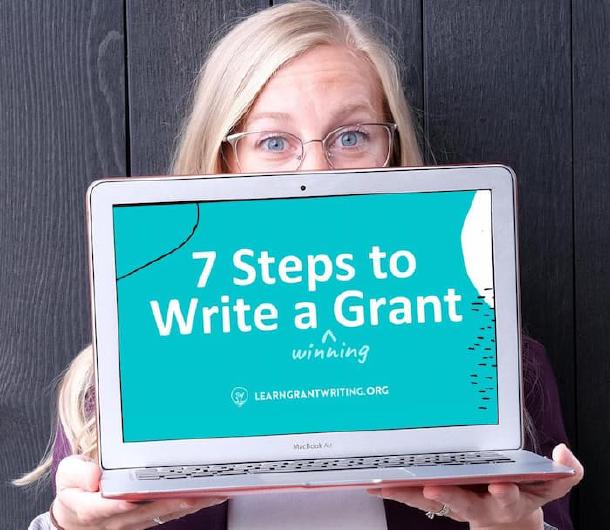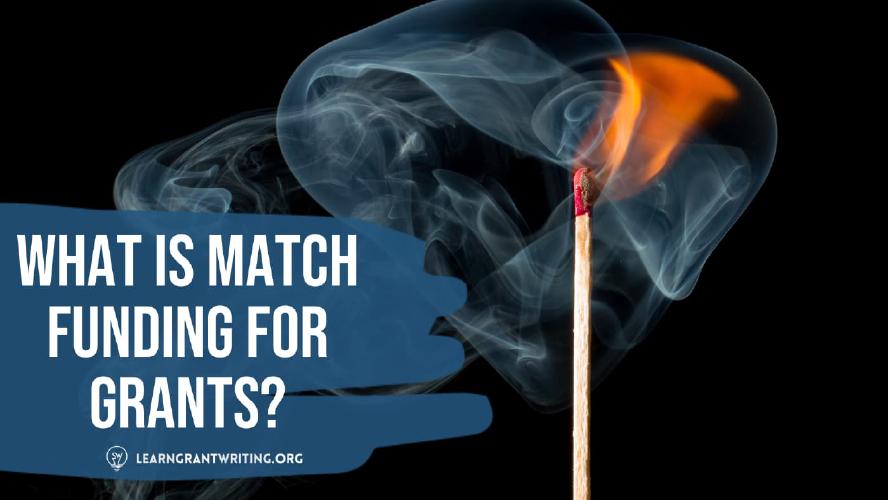In your grant writing efforts, you’ll most certainly come across funders that require a certain percentage of match dollars. This is especially common for federal grants. It can be tempting to simply delete those grants from your list of potential opportunities to pursue because perhaps you’re not sure what match is, it seems like a lot of work, or you don’t know where to find match.
Please don’t delete those grants from your list! I promise match isn’t scary. This blog post will break down what match is, how you can use it strategically, and where you can find match dollars. Our goal is to further equip you with necessary knowledge to find match for your grants and to think creatively about match sources. In other words, we’re here to help you sparkle like the grant writing unicorn that you are!
What is match funding for grants?
Match is the cash value of all the cost sharing made by you, the applicant, or your partners to help fund a project. In different terms, match is also known as cost share which can be defined as a detailed list of all the cost sharing being made by you, the applicant, or your partners.
As mentioned previously, grant applications often require that a certain amount of match is provided. For example, if a foundation requires 50% match, that means you need to demonstrate how you will pay for half the project. If you want to apply for $10,000, the total project cost would be $20,000. Your organization would be providing $10,000 or 50% match.
We realize that the concept of match concerns a lot of people and you may even feel inclined to say you are not interested in those grants. But hear us out: match is not something to be afraid of. The more you know about match, the more you’ll be confident in applying for grants that require match (read: sparkle like the grant writing unicorn that you are).
Discover Grant Writing as a Career
If you’re interested in becoming a grant writing consultant, check out this free training on how you can pull off a meaningful career change.
Access Free Class
What are the different types of match funding?
Yes, there are different types of match. What you can and cannot include as match will be clearly defined in the funding guidelines so be sure to read them carefully. If it isn’t clear, reach out to the funder for clarification. In our Global Grant Writers Collective program, we recommend printing out a hard copy of the funding guidelines to read, highlighting unique requirements as you go. We’re all for reducing paper waste, but in our experience, we tend to catch the little nuanced things more often when we read a physical copy versus a digital copy.
Cash Cost Share
This is exactly what it sounds like. Cash cost share is hard cash contributions being made by the recipient, subrecipient, or other partner for costs incurred and paid for during the project. This can be an organization’s personnel, supplies, equipment, etc. Essentially, if the item in your budget is being reimbursed by you the applicant or the subrecipient, it is cash cost share because it is a legitimate and real expense being paid for. It’s important to note here that all cash cost share must be necessary for the successful performance of the project.
In-Kind Cost Share
This is the type of match/cost share you are probably most familiar with hearing about. In-kind cost share encompasses all contributions to the project made by the subrecipient, consultant, partner, or anyone but you the applicant. These contributions often represent donated items or services. As such, in-kind cost share usually consists of volunteer personnel hours, donated existing equipment, and donated supplies.
Where do you find match funding?
I know that at this point in the article, it sort of sounds like match is person, like Mitch, and we’re obsessed with him. Match? Match? Stick with me. This is the section where I give you all the golden clues for where you can source the required match.
There are several sources to examine for match dollars and it can be really worthwhile to spend some time thinking creatively how to reach your required match. Before you cross a grant off your list because it requires match, take a day or two and brainstorm with a coworker potential match sources. Below outlines a few of those sources and specific examples of thinking outside the box for meeting match requirements. Hopefully these help get you started on brainstorming.
Leverage Other Grants
The best source of match are other grants. Check with the funding agency for specific restrictions on matching funds as Federal grants may have unique stipulations on utilizing other grants as match. Otherwise, private sector grants are a great match option for certain portions of the project.
This is one reason why at Learn Grant Writing we look for 2-5 grants to pursue per project (aka: a funding strategy). We want you to use those grants strategically in cohesion. We encourage you to think about leveraging your grants like dominoes. So, how can you do that?
Well, for example, we have a student who received a commitment of $25,000 from a philanthropist to get their idea off the ground. Before spending that $25,000, Jacqueline used that promise of funding to secure another $86,000 by communicating the urgency of matching the philanthropist’s donation to secure it. The full interview, in case you’re curious, is right here.

Cash Match
Again, cash match is any item in your budget that is being reimbursed by you the applicant or the subrecipient. Cash match can include:
Personnel: People in your organization working to deliver the project. These individuals will provide direct or indirect services for the grant-funded activities but who won’t be charged to the project’s budget expenditures as a line-item request to the funder. On a prorated basis, administrative, clerical, contracted, and facilities personnel can all be used as cash match line items. Note: salary for these personnel must be paid by your organization in order to be considered match.
Fringe Benefits: Extra benefits that supplement an employee’s salary like health insurance. Similar to personnel, you can offer these benefits as match for administrative, clerical, contracted, and facilities personnel that are directly related to the project. These benefits must be prorated based on the actual amount of time these staff members will contribute to funder-supported activities. To be abundantly clear, your organization pays these benefits.
Travel: All travel costs necessary to the performance of the project that your organization will pay for from its own funds.
Equipment: Items that have a useful life beyond one year like a computer. This equipment must be purchased by your organization and be directly related to the grant project.
Supplies: Items to be consumed during the project purchased by your organization with its own money.
Other places to look for cash match include:
Specialized Allocation: For example, when your chief financial officer or council transfers cash from the general operating funds account into a specially allocated account to be used only for cash matching funds.
General Operating Funds: Unrestricted monies to pay the day-to-day operating expenses of your organization. Due to the fact that these funds are unrestricted, you’re able to utilize them for match.
In-Kind Match
In-kind match encompasses all contributions to the project made by the subrecipient, consultant, partner, or anyone but you the applicant. In-kind cost share encompasses all contributions made by sub-recipients.
Construction: Eligible construction is any aspect of infrastructure work that will be donated by trade professionals or volunteers. This is only applicable if the project is a capital project including new construction or renovation of a physical structure.
Contractual: All costs related to sub-recipients. These include project partners, contractors, or specialized consultants. These individuals will lend their expertise and time to the project after it’s funded but whose expenses may not be requested from the grant-funder.
Equipment: Items that have a useful life beyond one year like a computer. You must document fair market value for each item. Eligible equipment must be on hand from existing inventory.
Indirect Costs: Expenses of doing business that are not readily identified with a particular grant, contract or project like the electricity bill. If you’re struggling to identify matching funds, use indirect charges as a matching contribution to be absorbed by your project. Make sure you know and follow each specific funder’s directions for how to include and calculate indirect charges.
Supplies: Items to be consumed during the project. Eligible supplies must be on hand from existing inventory.
Travel Expenses: Eligible travel must be grant-related for key or ancillary personnel, and money for the expenses can’t be requested from the grant funder.
Miscellaneous: Other eligible sources include utilities and telephone expenses related to implementing the project but that aren’t allowable line items in the funding request; printing, copying, postage, and evaluation expenses not included in contractual or supplies; and any other costs your project will incur that haven’t been requested from the funder.
👉 When you’re preparing your budget, avoid this #1 most common mistake: anything you list in the cost share tab must be accounted for in the other tabs. Otherwise you are cost sharing for an expense that isn’t listed. If you want a better example, here's a short YouTube video we made to describe this concept on a whiteboard.
How do you use match funding strategically?
You might be reading this wondering why you should pursue grants that require match dollars when other funders don’t. Is all the time and effort to find match dollars even worth it? Great question. We’re here to tell you that it is worth it.
Actually, it’s more than worth it for the following reasons: The reality is that funders want their dollars to go as far as possible. You establish urgency by showing that additional funding can be leveraged if this grant is awarded. Paint a picture in your narrative of grant funding you have pursued or will pursue to demonstrate the relationship between funding sources. This is where you put your storytelling and persuasive skills to work —make magic and compel the funder to award the grant.
Match allows you, as an organization, to show a donor the in-kind support and donations of the community. Match helps to demonstrate the rock solid foundation of support you have and that your organization is reliable. In other words, you can be trusted for financial stability. This also helps show the grant making agency your high level of commitment to achieving a fundraising goal. Again, the funder understands that your organization is established and faithful to your mission.
If match is reached through new money or new donors, it shows your organization is willing to put in the work to increase your donor base and find new ways to engage your community. New money is defined as 1) a gift of money or property that exceeds a donor's gift in the previous year, 2) a gift from a newly acquired donor, or 3) a large amount of money recently acquired by a person or family. Basically, new money and new donors are really good for your organization because it means that you’re growing and connecting with a wider community of supporters.
Free Grant Budget Template
If preparing a grant budget scares you, those days are about to be over! Download the free grant budget template below and take our free grant writing class to learn how to use it.
Free Template
Final takeaway
You do not need to be scared of match. Match, also known as cost share, is simply the cash value of all the cost sharing made by you, the applicant, or your partners to help fund a project. There are two primary types of match which are cash and in-kind contributions. Sources of match funding are not as elusive as one might initially think. Depending on the funding guidelines, you can use volunteer personnel hours, donated equipment, and/or cold hard cash to reach match requirements.
Moreover, match can help demonstrate to funders the strong support your organization has. Meeting or exceeding match proves to funders that their contributions are making a tangible difference through a well planned project that is set up for success.
For more tips and tricks on grant funding and writing a proposal, be sure to check out and follow us on Instagram for updates and course information.
Free Grant Writing Class
Learn the 7-steps to write a winning grant application and amplify the impact you have on your community.
Access Free Class






